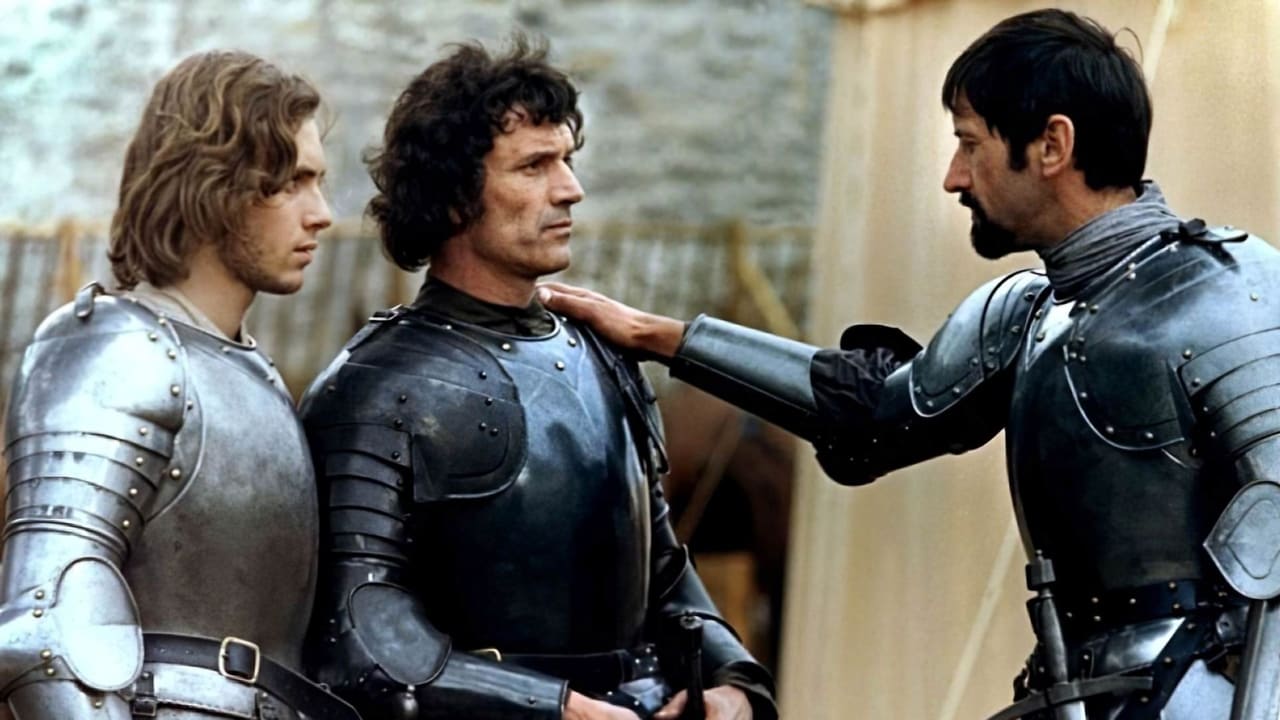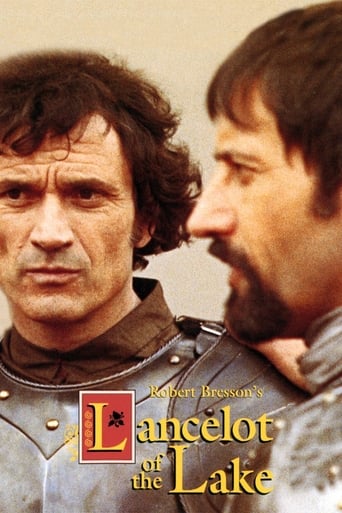

With "Lancelot of the Lake", director Robert Bresson takes the Arthurian legends – specifically Lancelot's affair with King Arthur's Queen, Guinevere – and removes the regality, romanticism, resplendence and reverence. What remains is perhaps the director's bleakest film, one in which cold blooded knights do petty and vile things to petty and vile people for petty and vile reasons."Lord, do not forsake me," Lancelot says before a crucifix. Significantly, Bresson's camera leaves the crucifix out of focus, for these knights spend the film focusing on themselves. They are the lords of these lands and God is a blur, men doing evil in Christ's name purely for their own selfish ends."It was not the Grail," Guinevere tells Lancelot, "it was God you all wanted!" But Lancelot doesn't listen. Bresson undercuts the self-importance, myopia and narcissism of his knights with scenes which stress how pathetic they truly are. Far from magnificent, their armour is clunky, ridiculous, and serves only as a reminder of how much they fear their own corporeality. And when they're not strutting about like clowns, Bresson spends time stressing how reliant on servants and peasants the knights have become. Scenes in which their feet are helped into stirrups by peasants and brief shots of the sad eyes and hooves of horses also recall Bresson's own "Au Hasard Balthazar", in which a donkey was forced to live its entire life in terror and misery. The knights induce and live in the same fear.As the film progresses, a kind of humble Christianity becomes increasingly perverted. The knights themselves are less concerned about spiritual matters than they are with competitive games (jousting, chess, duels, winning the favour of Kings and Queen), everyone looking to steal, and bask in, a little divine light.By the film's end, religion disappears entirely, an apocalyptic battle seemingly purging all the knights from the land. Always unconventional, Bresson stages the battle with a series of pans and medium shots. What violence is shown simply takes the form of wooden arrows being fired into the air and embedding themselves, not in armour and flesh, but the trunks of trees. We recall the blunt shots of falling trees in Bresson's "The Devil Probably". In "Lancelot", man too seems to have taken God's Eden and turned it evil, or perhaps destroyed it irrevocably. Last shot: corpses. Last word: "Guinevere". Even in death, Lancelot has nothing but desire and temptation on his lips.8/10 – Though interesting, this is but a smaller, and inferior, version of both Jancso's "The Red And The White" and Kurosawa's "Ran". The film needs at least two viewings to fully soak up Bresson nuances.
... View MoreIn Robert Bresson's short filmography, "Lancelot Du Lac" is probably his most dismissed piece of work for evident reasons. The author of such pearls like "Journal d'Un Curé De Campagne" (1951) and "au Hasard Balthazar" (1966) chose to adapt his minimal, inimitable style to the fabled tale of the Knights of the Round Table with Lancelot's adulterous love for the Queen Guenièvre. Was it an appropriated choice for a topic whose treatment inevitably required greatness, heroism, violence pertaining to a chivalrous tale?Well, viewers who aren't familiar with Bresson's genuine cinematographic approach won't approve of it with a basically epic story and the filmmaker seemed aware of it given his cinema is everything but spectacular. But the auteur pushed his ideas to the extreme. So, we have here an austere view of a story usually full of greatness with very little action. The film opens and ends after a fight with bodies falling down, horses running and a desolate battle ground in the heart of a deep green forest. In the middle of the film, the audience will be allowed to watch a tournament which Bresson will reduce to its simplest elements with flags waving, Gauvain and Arthur's looks, shots on some of the horsemen's characteristics like their horses' legs or their armors. Once again as in many Bresson's works, ellipses are given priority. When the two adversaries collide, one can't properly see the action but just the before and after.Between these rare, fragmented action sequences, the rest is devoted to an aging Lancelot and his relationships with Queen Guenièvre, King Arthur, Gauvain and the other knights. Proud characters have given way to weary ones. The Quest for the Holy Grail was lost and Lancelot attributes this defeat to the guilty love he has for Guenièvre. And he is torn between this serious mistake and the chivalrous demeanor he should adopt for Arthur. Gauvain is stuck in a similar situation between his respect for Lancelot and Arthur with whom he wants to remain faithful. Like in other Bresson works, redemption has a sizable role. Towards the end of the film, Lancelot wants to redeem himself by fighting with Arthur against Mordred. Animals also seem to play a small but vital role. A magpie is often on the branch of a tree facing the Queen's bedroom.It's no wonder this dry overhaul of the Knights of the Round Table baffled many viewers, especially the ones who have never heard of Bresson. Lines full of bitterness, regret or suspicion are recited by models with a monotonous voice and a stone-cold acting lead a film mostly deprived of action and violence. That's why I would only recommend it to Bresson's die-hard aficionados and not for newcomers who will be better served with John Boorman's "Excalibur" (1981).
... View MoreI noticed by the other reviews that there are other Monty Python and the Holy Grail fans out there. That's because in the first minutes of the movie, there are three fights that look VERY VERY reminiscent of the Black Knight scene from Monty Python. Considering that Monty Python came out one year later, I wonder if maybe they were inspired by the these incredibly stupid scenes from Lancelot of the Lake. In this opening montage, one obviously fake guy gets his head sliced off--complete with Monty Python-style blood. Then, one guy is stabbed (but it's obvious that the blood is not coming from the wound but pouring out of the trick sword). And finally, a guy has his head smashed in--complete with GALLONS of fake blood. These silly scenes already had me hating the film. In Monty Python, it was comedy and meant to be way over-the-top, but Bresson's film is meant to be a drama and the scenes are just shabby and inappropriate.But, then the movie shifts from lots of action to STATIC scenes where they talked and talked and talked and I became completely bored. Along the way, I noticed that the print on the DVD was very poor--all washed out and cheap looking. Considering this is the DVD, I doubt there is a better version available. But considering how uninspired and dull this is, I really wouldn't bother looking for a different print.
... View MoreSorry for that summary line, but the opening sequence with the armored knights on horses riding time after time past the same trees and the same bend in the trail, then the one knight getting his head cut off with the funny fake blood fountain squirting out of his neck, I just had to laugh. It looked too much like a famous Holy Grail spoof that I love. From that point on, I went from moment to moment, first leaning forward to experience Bresson's totally different take on the Round Table stake (mainly, his numerous stagings showing people standing in doorways or coming in or out of doors, often with just their legs and feet being shown plus an entire jousting tournament in which only the horses and their riders legs are seen and the unemotional line readings of the actors) and, second, doing my little Sandra Bullock-like snort laugh at what appeared to be parody but was clearly done in all seriousness the way the armor clanked kept getting funnier and funnier. This is one messed up, mixed up movie that left my head spinning. Its two extremes of presentation leave it (for me, anyway) totally unreviewable. Still, as a late film from an important director, it is a must-see for most of us film snobs.
... View More